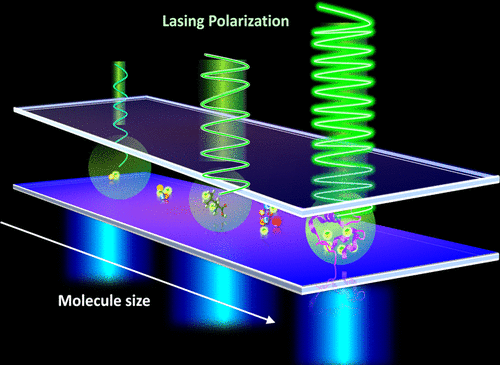当前位置:
X-MOL 学术
›
ACS Photonics
›
论文详情
Our official English website, www.x-mol.net, welcomes your feedback! (Note: you will need to create a separate account there.)
Distinguishing Small Molecules in Microcavity with Molecular Laser Polarization
ACS Photonics ( IF 7 ) Pub Date : 2020-07-23 , DOI: 10.1021/acsphotonics.0c00387 Zhiyi Yuan 1 , Xin Cheng 1 , Yunke Zhou 1 , Xiaotian Tan 2 , Xuerui Gong 1 , Hamim Rivy 1 , Chaoyang Gong 1 , Xudong Fan 2 , Wen-Jie Wang 3 , Yu-Cheng Chen 1, 4
ACS Photonics ( IF 7 ) Pub Date : 2020-07-23 , DOI: 10.1021/acsphotonics.0c00387 Zhiyi Yuan 1 , Xin Cheng 1 , Yunke Zhou 1 , Xiaotian Tan 2 , Xuerui Gong 1 , Hamim Rivy 1 , Chaoyang Gong 1 , Xudong Fan 2 , Wen-Jie Wang 3 , Yu-Cheng Chen 1, 4
Affiliation

|
Microlasers have emerged as a promising approach for the detection or identification of different biomolecules. Most lasers were designed to reflect changes of molecular concentration within the cavity, without being able to characterize biophysical changes in the gain medium. Here, we report a strategy to extract and amplify polarized laser emissions from small molecules and demonstrate how molecular rotation interplays with lasing at the nanoscale. The concept of molecular lasing polarization was proposed and was first evidenced to increase accordingly as the fluorophore binds to larger biomolecules in a microcavity. By detecting the molecular rotational correlation time through stimulated emission, small molecules could be distinguished, while conventional fluorescence polarization cannot. Theoretical models were developed to elucidate the underlying mechanisms. Finally, different types of small molecules were analyzed by adopting a Fabry-Pérot optofluidic laser. The results suggest an entirely new tool to quantify small molecules and guidance for laser emissions to characterize biophysical properties down to the molecular level.
中文翻译:

用分子激光偏振识别微腔中的小分子
微激光已经成为检测或鉴定不同生物分子的有前途的方法。大多数激光器被设计为反射腔内分子浓度的变化,而无法表征增益介质中的生物物理变化。在这里,我们报告了一种从小分子中提取和放大偏振激光发射的策略,并演示了分子旋转如何与纳米级的激光相互作用。提出了分子激光极化的概念,并且首先证明了随着荧光团与微腔中更大的生物分子结合,分子激射极化的概念随之增加。通过检测受激发射的分子旋转相关时间,可以区分小分子,而常规的荧光偏振则不能。开发了理论模型以阐明潜在的机制。最后,通过采用Fabry-Pérot光电流体激光器分析了不同类型的小分子。结果提出了一种全新的工具,可以量化小分子,并指导激光发射以表征低至分子水平的生物物理特性。
更新日期:2020-08-19
中文翻译:

用分子激光偏振识别微腔中的小分子
微激光已经成为检测或鉴定不同生物分子的有前途的方法。大多数激光器被设计为反射腔内分子浓度的变化,而无法表征增益介质中的生物物理变化。在这里,我们报告了一种从小分子中提取和放大偏振激光发射的策略,并演示了分子旋转如何与纳米级的激光相互作用。提出了分子激光极化的概念,并且首先证明了随着荧光团与微腔中更大的生物分子结合,分子激射极化的概念随之增加。通过检测受激发射的分子旋转相关时间,可以区分小分子,而常规的荧光偏振则不能。开发了理论模型以阐明潜在的机制。最后,通过采用Fabry-Pérot光电流体激光器分析了不同类型的小分子。结果提出了一种全新的工具,可以量化小分子,并指导激光发射以表征低至分子水平的生物物理特性。


























 京公网安备 11010802027423号
京公网安备 11010802027423号